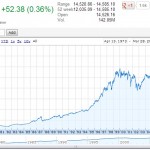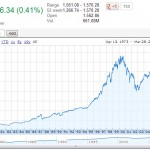S&P & dow jones were at these levels in 2000, 2007 and now. Snapshots attached.
One thing that is very interesting (academically at least) for me to understand is to see if there is quantitative rationale that explains why the current level is not due to a bubble whereas it was based on a bubble in 2000 and 2007? Do you know the answer to this question? Or do you think that current level is also due to a bubble? If it is then what bubble is it? I specified “quantitative rationale” because I can assuming that in the hindsight you can find some ratios that signify the existence of some abnormality. So whether it was say historical pe ratios of the index companies or whatever else.
One “new information” right now is the existing of financial troubles across the rest of the world. Is that the key driver here?
Do you think this is a completely wrong way of looking at this thing? 🙂 If it is then please enlighten. Its ok if you have a qualitative reason that may not be able to be explain with straight easy to find numbers.





One clear reason is that Earnings for the S&P 500 hit $103 per share last year. That’s up from $84 in 2007 and $61 in 2009. So corporate profits are at an all-time high. So then the question is if corporate profits are high due to any kind of bubble? If yes, which one? Is it because of low interest rates? Or is it fundamental productivity gains and if that is sustainable?
I know, too many questions!
Interesting questions…which has in-turn created more questions – What is the definition of a bubble ?
Internet stocks, for example, were first described as a “bubble” in 1995, a full five years before the peak. And the amount of money made in those next five years made everyone who was skeptical early on look and feel like a fool. House prices, meanwhile, were described as a “bubble” as early as 2002 and 2003. And it wasn’t until 2007, many years later, that house prices finally peaked.
@Bhavesh….the general definition of bubble would be “unsustainable valuation for a certain asset”. what you are raising is a good point which is “At what point an asset valuation should be considered as reaching unsustainable level?” The reason why its almost impossible to pin-point a bubble is that the answer for that question is not just different for different situations but there is almost always some “new information” that we can’t evaluate based on the past ratios of what it is that we are evaluating. So In late 90’s it was mostly around the sustainability of the revenue models for web companies. We never had any historical data to suggest whether that is sustainable or not. In case of housing bubble, it was around sustainability of cheaper financing of real estate (I guess?)
So to re-frame the question differently, is there any indicator that says something is unsustainable right now when you look at the reasons why S&P and dow are at all-time highs? As I pointed out, it could be productivity gains in today’s case or it could be low interest rates or it could financial troubles in the rest of the world. Big question is which one is it and at what time it becomes unsustainable?
@Manish,
I think the DOW and S&P are at all time highs as the amount of money that is printed by all the governments is at all time high. This cheap money finds it way to the stock market as no where else you will get a decent return on your money and hence the indices keep going high. QE3 – Quantitive easing as it is called where in the Government keeps buying mortagage backed securities ($40 billion in mortgage-backed securities that it will buy each month)….
Read more: http://business.time.com/2012/09/14/too-much-candy-a-plain-and-simple-way-to-understand-quantitative-easing-part-3/#ixzz2PG7KCed8
Warren Buffet on Bubbles:
Beware when investing turns into speculating…Speculation give rise to Bubbles bubbles….
“The line separating investment and speculation, which is never bright and clear, becomes blurred still further when most market participants have recently enjoyed triumphs. Nothing sedates rationality like large doses of effortless money. After a heady experience of that kind, normally sensible people drift into behavior akin to that of Cinderella at the ball. They know that overstaying the festivities ¾ that is, continuing to speculate in companies that have gigantic valuations relative to the cash they are likely to generate in the future ¾ will eventually bring on pumpkins and mice. But they nevertheless hate to miss a single minute of what is one helluva party. Therefore, the giddy participants all plan to leave just seconds before midnight. There’s a problem, though: They are dancing in a room in which the clocks have no hands.”
Source: Letter to shareholders, 2000
Today on yahoo the article was posted…
http://finance.yahoo.com/blogs/daily-ticker/stockman-bubbles-over-hide-cash-150205492.html
@Nilesh….It is interesting that he very clearly says that its going to start showing up in the bond market. So its worth tracking that one and see what happens with it. I have been hearing about bond market collapse for couple of years now and it remains to be seen when that actually happens (if it does).
But there is something I don’t clearly understand here and that is the causation (i.e. beyond just a correlation) between excess “cheap money?” pumped by fed into the system and the corporate profits being at all time high. Is it that corporates are now able to get cheaper money and turn that into real profits? But then that should show up very clearly into their balance sheets and that is too obvious which tells me that maybe there is an indirect causation here? Wonder what? Maybe I should ping one of the macro economics profs to see what his thoughts are 🙂
@Manish
I completely agree with Nilesh’s post. There is so much money being printed not only by US Fed but also by governments of other countries and one way or other money finds its way to the stock market.
About the corporate profits, I think that is not a complete metric for comparison. Profits are function of revenue and expenses. It is also important to consider whether the revenues have grown with the same proportion. Chances are they have not. Between 2003 to date, most of the S&P companies have lowered their expenses by off shoring their services and manufacturing.
One other thing to note is in 2007, the unemployment rate was below 5% but today it’s hovering around 7.5 and yet the stock market is @ it’s high. This further proves the point that the markets are going up because of QEs around the world.
@Amit…..I guess you are making 3 points here (maybe related)
1. So if I understand it correctly, you are pointing to excess cheap money flowing into the stock market via the investors as a possible reason for markets being at all time high. Even though it may be contributing to it but the fact is that the corporate profits are truly at an all time high which means that pe ratios are not inflated and so its not a bubble from that perspective? In other words I would think that even if there wasn’t cheap money from the Fed, the current situation with corporate profits seems to be a sufficient condition for the markets to reach highs
2. Regarding profits, yes I agree that increase in profits doesn’t necessarily mean that the revenues are also increasing at the same rate. And the following report points to that to a certain extent (see page 3 of this pdf which shows both earnings and revenue y-o-y growth). However note that revenues are not really stagnant either http://www.yardeni.com/pub/PEACOCKSP500.pdf
3. Higher earnings rates compared to the revenues basically points to increased productivity (includes outsourcing) which is a perfectly legitimate reason for the markets to react in a positive manner unless there is a clear reason that we will go back to older productivity levels? This also perfectly ties in with the fact that even though we are at all time highs for the markets, the unemployment is still nowhere close to its 2005 levels. In other words, I am not sure if all-time high markets in the face of higher unemployment proves QE as the reason because again, productivity gains are a sufficient and legitimate condition for markets to go high.
@Manish
Increased productivity will help the stock market to a certain extent (the market turned from lows and went past previous highs). Said differently, you can only cut so many expenses and so much cost. As per traditional fundamentals, in order to have sustainable growth of stock market, it is imperative that the revenues (also referred to as top line growth) of the companies should grow proportionate to the net profits (also referred to as bottom line growth), if not faster.
But the stock market is @ all time highs in spite of the traditional fundamentals not aligning.
So I completely agree with the fact that the stock market is just going higher because of excess cheap money available
http://www.nytimes.com/2013/05/10/opinion/krugman-bernanke-blower-of-bubbles.html?hp
hmm. Interesting. I don’t think I have an answer to this but thought of sharing this audio podcast that I came across while doing some research for my behavioral finance class.
http://www.sciencemag.org/content/322/5908/1624/suppl/DC1
Chelsea Wald highlights that Conventional financial models don’t take into account the human behavior which is a major factor in the financial crisis. New models are being designed to take into account psychology & sociology and look at adaptive market hypothesis instead of efficient market hypothesis and may be used to predict bubbles. However financial crises may be an unavoidable aspect of modern capitalism, a consequence of the interactions between hard wired human behavior and the ability to innovate, compete and evolve.